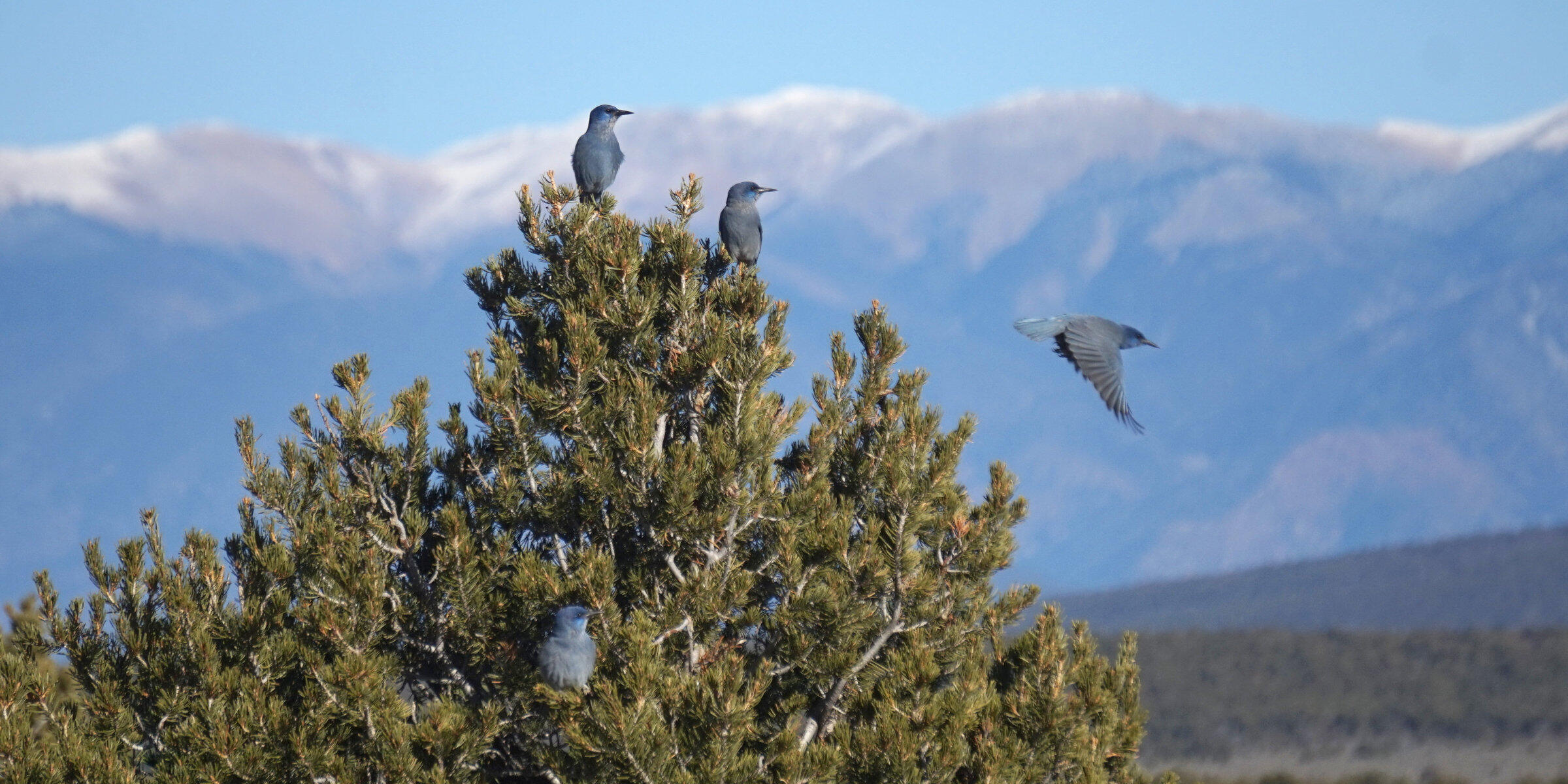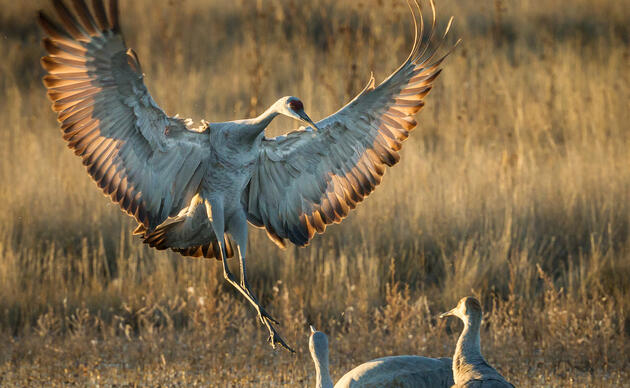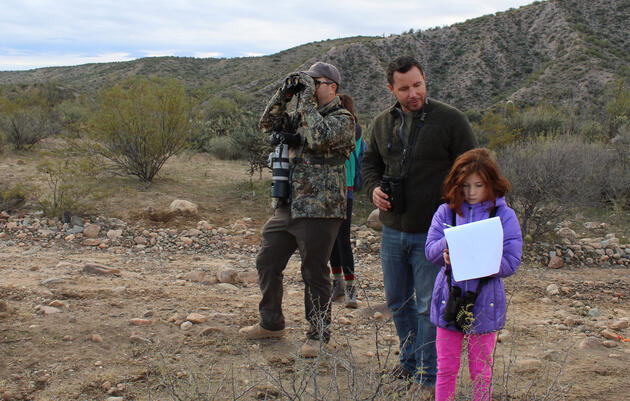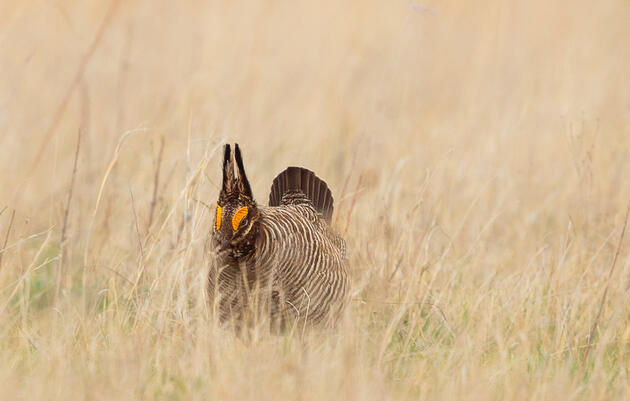The Pinyon Jay (Gymnorhinus cyanocephalus) is an iconic bird of the intermountain west and was once common throughout the Pinyon-Juniper woodlands of northern Arizona and New Mexico, southern Utah, and portions of Nevada and Colorado. This colonial species’ diet is comprised largely of Pinyon Pine nuts and the species can be quite nomadic in pursuit of this favored food. Long term drought, climate change, and habitat conversions have resulted in astonishing Pinyon Jay population declines. From 1967–2015, populations fell by 3.69% annually for an estimated total loss of 83.5%
It would seem ironic that as Pinyon-Juniper trees encroach into some grasslands, Pinyon Jays, specialists in this habitat type, are languishing precipitously. Although the specific reasons for this decline remain unclear, it is likely that Pinyon trees are suffering from long-term drought, increasing temperatures, and other climatic shifts. Research suggests that these changes are leading to pinyon pines that produce fewer nuts. The birds seem to be ranging further from historic colony sites and might be relying more heavily on other food sources such as juniper berries and insects. Meanwhile, land managers find themselves in a double bind needing to both preserve grasslands and protect Pinyon Jay habitat. Guidelines for grassland preservation with an eye to the jay are lacking.
How to help:
You don't have to be an expert birder to help. Sign-up here! Community scientists play a critical role in gathering crucial data on a scale not otherwise possible! Join Audubon in-person or virtually for an orientation to Pinyon Jays and to a simple protocol. We have a spectrum of engagement opportunities from birding in your neighborhood to visiting a pre-defined survey block.
Attend our upcoming events and celebrate the Pinyon Jay:
Workshops
Workshops are a free and fun way to learn more about the program and meet like-minded individuals. Learn more here.
Ready to get started now? You can!
- Join Great Basin Bird Observatory’s data hub by building a free profile. (Use “_ASW” in your username, and we will add you to the Audubon Southwest Pinyon Jay Monitoring Group. Username example: “PeterPinyon_ASW”)
- Download Esri’s free Survey 123 app on your smart phone (available at your favorite app store) and log in with your Hub username and password. Once you are added to the ASW group, you will automagically have access to our data intake form
- Read over the data collection instructions
- Record your sightings, or lack of sightings. You can survey anytime, in any Pinyon-Juniper woodland or adjacent area.
Adopt a Trail
For the first time, volunteers registered in Great Basin Bird Obervatory's data hub under Audubon Southwest group (ASW) can adopt a 1 KM transect either on a road or trail and agree to visit three times a year to look for Pinyon Jays. The protocol (using the smart phone) remains the same, what is different isreturning to the same, pre-determined place multiple times, and using a different (but still free phone app), Field Maps. Currently, only availble in Arizona, there are 11 "trails" available for adoption, each selected by land managers as priorities for survey. Join us at the Flagstaff workshop for more information about the new component.
Supporting Organizations:
Great Basin Bird Observatory : Already surveying Pinyon Jays with GBBO? Enter your data, get a refresher on the Survey123 app, and learn about Pinyon Jay Natural History by visiting their Pinyon Jay community science page.
Arizona Bird Conservation Initiative: Coordinated by the Arizona Game and Fish Department, the Arizona Bird Conservation Initiative (ABCI) is a voluntary partnership of government agencies, conservation groups, academic institutions, private businesses, and citizens working to conserve, monitor, and enhance bird populations and their habitats with the goal of “keeping common birds common.” An integral component of ABCI, is the Arizona Coordinated Bird Monitoring Program (AZCBM). The program coordinates implementation of existing projects, supports projects implemented by partners, and collaborates on the design and implementation of new projects with interested stakeholders. The initiative is working with partners to better understand the distribution and habitat use of Pinyon Jays in Arizona.
Defenders of Wildlife: Defenders of Wildlife envisions a future where diverse wildlife populations in North America are secure and thriving, sustained by a network of healthy lands and waters. Our conservation efforts are targeted at the full range of vulnerable North American biodiversity, from plants to pollinators to predators. Our approach is direct and straightforward – We protect and restore imperiled species throughout North America by transforming policies and institutions and by promoting innovative solutions.
Grand Canyon Trust: The Grand Canyon Trust's Pinyon Jay Project is great for anyone, including those with limited birding experience. They are looking for volunteers to help gather information about Pinyon Jays to inform sound management of pinyon and juniper forests throughout the Colorado Plateau. This is an independent community science project. You do the online training, then you choose where, when, and how many hours you want to contribute. They encourage participants to observe the Pinyon Jays at least four times throughout the year, ideally in four different locations. Also, they encourage folks to observe in and around the Grand Staircase-Escalante National Monument area, since that is where proposals for large-scale tree removal projects that threaten the birds' habitat are being seen.
Kaibab National Forest: The Kaibab National Forest is partnering with the Arizona Game and Fish Department, Great Basin Bird Observatory and Audubon to assess both pinyon jay habitat use and pinyon nut availability, and to explore community science to support monitoring. We hope to harness the enthusiasms of recreational birders to both collect data and help spread the word about potential threats. The project provides critical information for the Kaibab National Forest for landscape-level evaluation effectiveness of land treatments with an eye to effects of this restoration work on the Pinon Jay. A secondary benefit includes preliminary identification of pinyon nut availability, as Pinyon Jays serve as short- and long-distance seed dispersers and play key role in maintaining ecosystem integrity. The Kaibab NF monitoring plan identifies pinyon nut production as an area of cultural significance for certain tribes and areas of mast production will be identified during territory surveys.
Partners in Flight: Partners in Flight (PIF) identifies Pinyon Jay as a yellow Watch List species with a goal of reversing population declines. PIF criteria for inclusion as a yellow Watch List species is due to population declines and threats to habitats on breeding and nonbreeding grounds. Learn more about their Pinyon Jay Working Group here.
Utah Division of Wildlife Resources: Utah Division of Wildlife Resources: The Utah Division of Wildlife Resources identifies the Pinyon Jay as a "Species of Greatest Conservation Need" (SGCN). A species is classified as a species of greatest conservation need in the Utah Wildlife Action Plan if it is likely to undergo substantial population declines in all or part of its natural region without management intervention. Learn more about their work here.
Related
Community Science
Engage in community science by joining a bird count, survey, or other opportunity.
Take Action
Use your voice for birds, and take action to advocate for them and the places they need.
How you can help, right now
Join the Western Water Action Network
Receive action alerts about water issues, and issues that are affecting birds across the arid West.
Donate
Help secure the future for birds at risk from climate change, habitat loss, and other threats. Your support will power our science, education, advocacy and on-the-ground conservation efforts.
Nina Mason Pulliam Rio Salado Audubon Center
Visit the Nina Mason Pulliam Rio Salado Audubon Center in Phoenix, Arizona.







